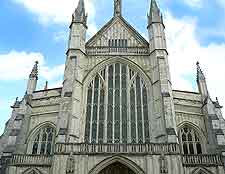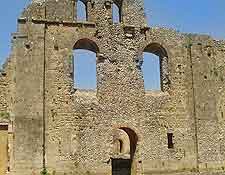Winchester History Facts and Timeline
(Winchester, Hampshire, England)

Throughout its history, Winchester has been closely associated with kings and bishops. Both have had a strong influence on the life of the city and its inhabitants.
Winchester's story began in 150 BC, with evidence that an Iron Age hill fort was built on the present-day site of Oram's Arbour. There's also evidence of a thriving Roman city, known as Venta Belgarum, on the site.
From Saxons to Normans
We have to look to the Saxon era to see Winchester achieve its preeminence. In 635 AD, the Saxon King Cynegils founded the first Christian church, known as the Old Minster. Then, in 871 AD, King Alfred the Great was crowned here and made the town his capital.
A new minster, known as Nunnaminster, was founded. The legend of St. Swithun is said to originate in 10th-century Winchester. On a July day in 971 AD, Swithun's grave was opened up to transfer it from the New to the Old Minster. Forty days of rain followed. Today, it's still said that if it rains on 15th July, then England is destined for a wet summer.
In 1066, Winchester fell under the control of King William the Conqueror. For a while, Winchester remained at the heart of royal rule. William extended the royal palace, built a castle and, in 1079, started work on the current cathedral. He also ordered the Domesday Book to be compiled here.

From the Middle Ages to Tudor Times
In the Middle Ages, the city was one of the most powerful bishoprics in the Church of England. In 1160, the illuminated Winchester Bible was created here. The city was still also the home of royalty. In the 13th century, King Henry III modernised the castle, although a fire in 1302 destroyed the castle's royal apartments. Henceforth, royal visitors stayed at Wolvesey Castle, which had been built by the Bishop of Winchester in 1110 and later converted into a palace.
In 1394, Winchester College was founded by William of Wykeham. It has the longest continuous history of any school in England. Originally, it opened to educate poor scholars. However, in the 19th century, fee-paying students, known as commoners, were allowed to enter the school.
Winchester continued to entertain royalty from all over Europe. In 1522, King Henry VIII entertained Emperor Charles V in the Great Hall, and in 1554, crowds gathered to see Queen Mary Tudor marry Prince Philip of Spain at the cathedral.
From the 17th Century to the Present
Both castle and cathedral were to suffer greatly during the English Civil War of the mid-17th century. The city was subjected to several sieges and the destruction of its buildings. Gradually, it fell into a decline.
The city's revival began in the reign of King Charles II. He began to build a palace in Winchester. Although construction work stopped on his death, the city was still popular with royalty, including the Hanoverians. As a Georgian city, Winchester was something of a regional centre for aristocrats and writers, and Jane Austen lived here at one stage. The city's success continued under Queen Victoria. New buildings helped to express its growing optimism, including the Guildhall and King Alfred's College. In 1901, a huge bronze statue was erected to commemorate King Alfred's death.
More recently, Winchester has been somewhat overshadowed by the growth of larger towns and cities. However, the city continues to attract crowds of tourists, drawn by its well-preserved heritage.
 Throughout its history, Winchester has been closely associated with kings and bishops. Both have had a strong influence on the life of the city and its inhabitants.
Throughout its history, Winchester has been closely associated with kings and bishops. Both have had a strong influence on the life of the city and its inhabitants.